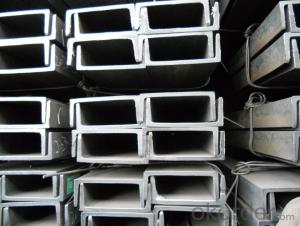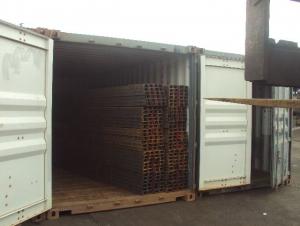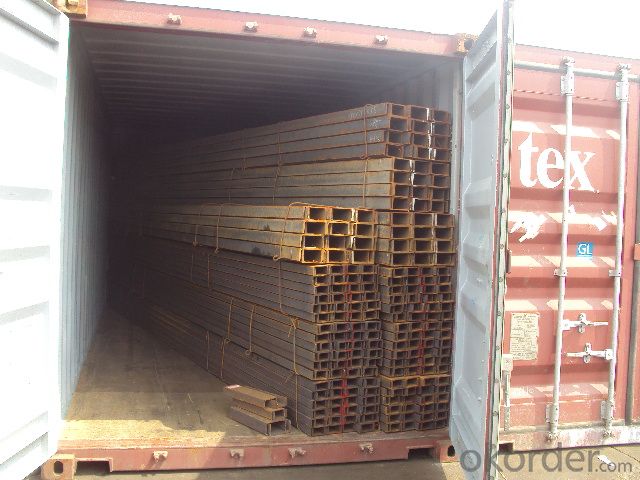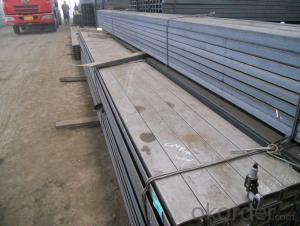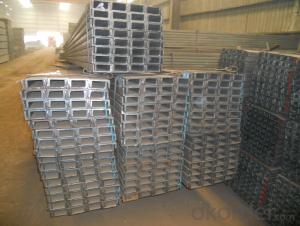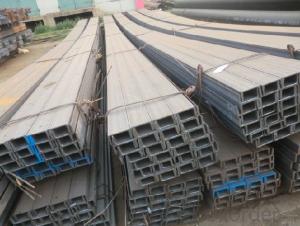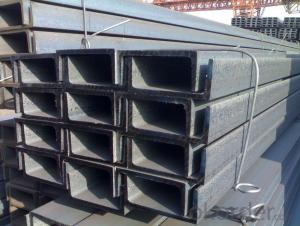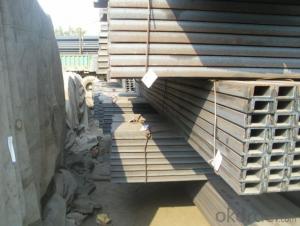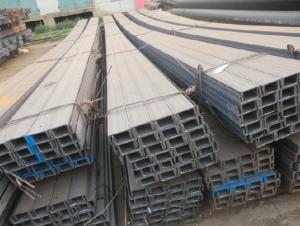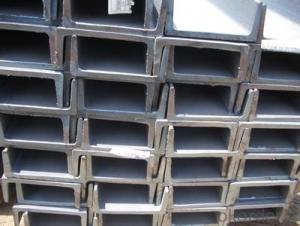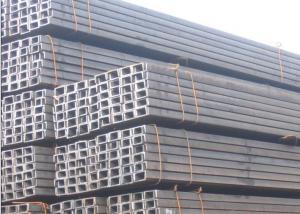U-channel Carbon Steel JIS Standard Many Sizes Hot Rolled
- Loading Port:
- Tianjin
- Payment Terms:
- TT OR LC
- Min Order Qty:
- 25 m.t.
- Supply Capability:
- 2000 m.t./month
OKorder Service Pledge
OKorder Financial Service
You Might Also Like
Product Description:
OKorder is offering U-channel at great prices with worldwide shipping. Our supplier is a world-class manufacturer of steel, with our products utilized the world over. OKorder annually supplies products to European, North American and Asian markets. We provide quotations within 24 hours of receiving an inquiry and guarantee competitive prices.
Product Applications:
1.The JIS channel can be devided into two kinds, namely common channel steel and light channel steel. The sizes of hot rolled common channel steel range from 5# to 40#. Meanwhile, the channel steel can be divided into cold forming sectional equal channel steel, cold forming sectional unequal channel steel, cold forming inner edge channel steel and outer edge channel steel.
2.The JIS channel is usually used for arch-itechtural structure, and they could be welded in order to support or hang a vari-ety of facilities. They are also usually used in combination with I beam. The channel steel with sizes under 14# is usually applied to construction engineering, as purline, while the channel steel with sizes above 16# is more likely to be used in building vehicle chassis structure and mechanical structure. Furthermore, the channel steel in sizes above 30# are target at building bridge structure, as tension bar.
Product Advantages:
OKorder's U-channel are durable, strong, and resist corrosion.
Main Product Features:
· Premium quality
· Prompt delivery & seaworthy packing (30 days after receiving deposit)
· Corrosion resistance
· Can be recycled and reused
· Mill test certification
· Professional Service
· Competitive pricing
Product Specifications:
1.We are able to provide channel steel of top quality at attractive price.
2.Our products of channel steel have passed ISO9001:2008 Quality Management System Certification.
Alloy No | Grade | Element (%) | |||||
C | Mn | S | P | Si | |||
Q235 | B | 0.12—0.20 | 0.3—0.7 | ≤0.045 | ≤0.045 | ≤0.3 | |
Alloy No | Grade | Yielding strength point( Mpa) | |||||
Thickness (mm) | |||||||
≤16 | >16--40 | >40--60 | >60--100 | ||||
≥ | |||||||
Q235 | B | 235 | 225 | 215 | 205 | ||
Alloy No | Grade | Tensile strength (Mpa) | Elongation after fracture (%) | ||||
Thickness (mm) | |||||||
≤16 | >16--40 | >40--60 | >60--100 | ||||
≥ | |||||||
Q235 | B | 375--500 | 26 | 25 | 24 | 23 | |
Note of U-channel
1. According to national standard (GB) for our products, if not, supply according to national standards (GB) or agreement.
2. We can not only provide electric furnace +LF+VD and electros lag re-melting (ESR) steel forging materials, but also forging products of piece, bar, etc.
3. Our company is equipped with roll equipment and can provide our customers with roll billets or finished.
4. The materials that we purchase are all accord with International General Standard; you could check it out on the Material Quality Sheet.
5. We are the creator of the “seven-step inspect method” in China.
6. The technical workers we employed are the ones with many years’ working experience, who know the technology procedures very well.
FAQ:
Q1: Why buy Materials & Equipment from OKorder.com?
A1: All products offered byOKorder.com are carefully selected from China's most reliable manufacturing enterprises. Through its ISO certifications, OKorder.com adheres to the highest standards and a commitment to supply chain safety and customer satisfaction.
Q2: How do we guarantee the quality of our products?
A2: We have established an advanced quality management system which conducts strict quality tests at every step, from raw materials to the final product. At the same time, we provide extensive follow-up service assurances as required.
Q3: How soon can we receive the product after purchase?
A3: Within three days of placing an order, we will begin production. The specific shipping date is dependent upon international and government factors, but is typically 7 to 10 workdays.
Images:
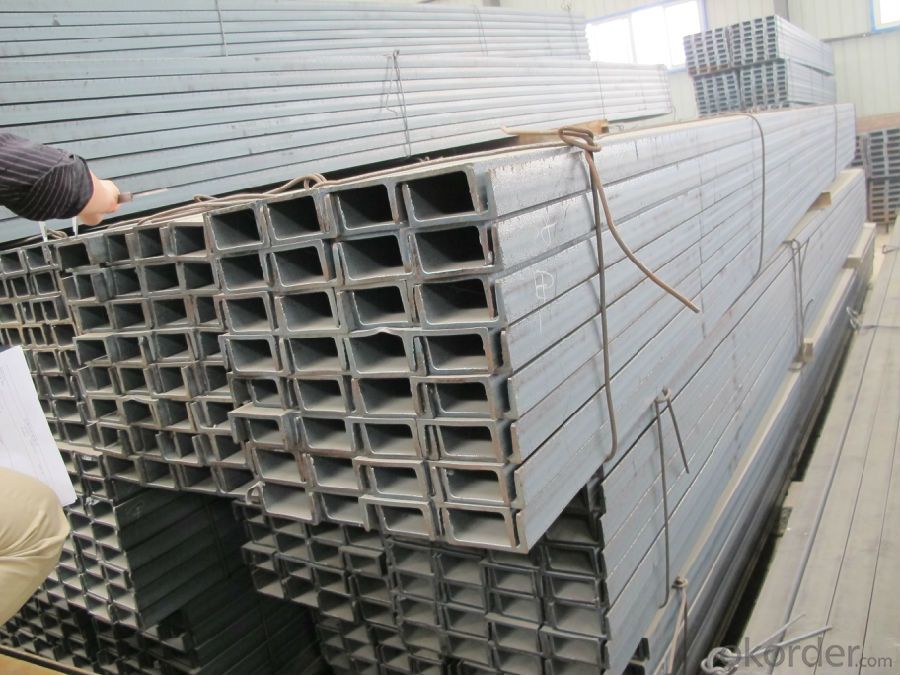

- Q: Can steel channels be used for overhead crane systems?
- Yes, steel channels can be used for overhead crane systems. Steel channels are commonly used as structural components in construction and industrial applications due to their strength and durability. They provide a stable and secure framework for supporting the various components of an overhead crane system, including the bridge, trolley, and hoist. Steel channels offer excellent load-bearing capacity and can withstand the heavy loads and stresses associated with crane operations. Additionally, they can be easily fabricated and customized to meet the specific requirements of the crane system, such as length, width, and thickness. Overall, steel channels are a reliable and efficient choice for overhead crane systems.
- Q: How do steel channels contribute to the overall structural integrity of a building?
- The utilization of steel channels plays a pivotal role in augmenting the overall structural soundness of a building. These essential structural constituents are frequently employed in construction projects due to their exceptional robustness, endurance, and adaptability. Generally, steel channels are fashioned into C-shaped or U-shaped beams using steel, which confers numerous advantages for the structural stability of a building. Primarily, steel channels proficiently distribute and convey loads. As a result of their configuration, steel channels are adept at supporting heavy loads and evenly dispersing them across multiple points. This equitable allocation of weight obviates the occurrence of concentrated stress points, thereby mitigating the risk of structural failure. Additionally, steel channels possess a high load-bearing capacity, enabling them to endure substantial forces and guarantee the overall steadiness of the building. Secondarily, steel channels offer resistance against bending and torsion forces. Their shape and material composition empower them to resist deformation under pressure, guaranteeing that the building maintains its structural integrity even under extreme conditions such as earthquakes or strong winds. By averting excessive deflection, steel channels aid in maintaining the safety and security of the building. Moreover, steel channels boost the rigidity and stability of the structure. By connecting various components of the building, such as beams, columns, and walls, steel channels effectively eliminate any potential weak points or gaps. This comprehensive integration of different elements contributes to the overall strength and stability of the building, precluding any potential structural failures. Lastly, steel channels provide flexibility in design and construction. They can be easily customized to suit specific architectural requirements, allowing for innovative and efficient building designs. The versatility of steel channels empowers architects and engineers to optimize the strength and stability of the structure while preserving aesthetic appeal. In conclusion, steel channels play a significant role in bolstering the overall structural integrity of a building by efficiently distributing and conveying loads, resisting bending and torsion forces, enhancing rigidity and stability, and providing design flexibility. Their strength, durability, and versatility render them an indispensable component in contemporary construction, ensuring the safety and longevity of buildings.
- Q: What does channel C20 mean?
- Represents 20# channel steel. C is the symbol of channel steel.
- Q: Are steel channels suitable for data center construction?
- Yes, steel channels are suitable for data center construction. They provide strength and durability required for supporting heavy equipment and infrastructure in data centers. Steel channels also offer flexibility for customization and ease of installation, making them a commonly used material in data center construction.
- Q: What are the different types of connections for steel channels in modular construction?
- In modular construction, steel channels are commonly used for structural purposes due to their strength and versatility. There are several types of connections that can be used with steel channels in modular construction. These connections are designed to provide structural integrity and stability to the modular building. One of the most common types of connections for steel channels is bolted connections. Bolted connections involve the use of bolts to connect two or more steel channels together. This type of connection is relatively easy to install and provides excellent strength and stability. Bolted connections can be used in various configurations, such as end-to-end connections or connections at angles. Welded connections are another popular type of connection for steel channels in modular construction. Welded connections involve the fusion of two or more steel channels using heat and pressure. This type of connection provides a strong and durable bond between the channels, ensuring structural stability. Welded connections are commonly used in applications where high load-bearing capacity is required. Another type of connection for steel channels is the use of brackets or cleats. Brackets or cleats are metal pieces that are attached to the steel channels using bolts or welds. These brackets or cleats provide additional support and reinforcement to the connection, enhancing the overall strength and stability of the modular structure. In some cases, steel channels in modular construction may also be connected using adhesive or epoxy. Adhesive connections involve the use of high-strength adhesives or epoxy resins to bond the steel channels together. This type of connection is often used in applications where a seamless and aesthetically pleasing finish is desired. It is important to note that the type of connection used for steel channels in modular construction depends on factors such as the load-bearing requirements, the specific modular design, and the construction method. It is crucial to work with experienced engineers and construction professionals to determine the most suitable connection type for a specific modular construction project.
- Q: What are the different methods of corrosion protection for steel channels?
- There are several methods of corrosion protection for steel channels, each with its own advantages and suitability for different environments. Some of the commonly used methods include: 1. Galvanization: This method involves applying a layer of zinc to the surface of the steel channel. The zinc acts as a sacrificial anode, corroding in place of the steel and protecting it from corrosion. Galvanization can be done through hot-dip galvanization, where the steel is immersed in a bath of molten zinc, or through electro-galvanization, which involves the electrochemical deposition of zinc onto the steel surface. 2. Painting or Coating: Applying a protective paint or coating to the steel channel can provide a barrier between the metal and the corrosive elements in the environment. There are various types of paints and coatings available, such as epoxy, polyurethane, or powder coatings, each offering different levels of resistance to corrosion and durability. 3. Cathodic Protection: This method involves connecting the steel channel to a sacrificial anode, such as zinc or aluminum, and creating an electrical circuit. The anode corrodes instead of the steel, effectively protecting it from corrosion. Cathodic protection is particularly useful in submerged or buried environments where galvanic corrosion is more likely to occur. 4. Stainless Steel: Using stainless steel channels is another effective way of protecting against corrosion. Stainless steel contains a high percentage of chromium, which forms a passive oxide layer on the surface, providing excellent resistance to corrosion. Stainless steel channels are commonly used in industries where corrosion resistance is crucial, such as marine or chemical industries. 5. Corrosion Inhibitors: These are chemicals that can be applied to the steel channel to inhibit or slow down the corrosion process. Corrosion inhibitors work by forming a protective film on the surface or by altering the chemical environment around the steel, making it less conducive to corrosion. However, the effectiveness and longevity of corrosion inhibitors may vary depending on the specific application and environment. It is important to consider factors such as the operating environment, anticipated lifespan, and budget when selecting a corrosion protection method for steel channels. Consulting with corrosion experts or engineers can help determine the most suitable and cost-effective method for a specific application.
- Q: How do steel channels contribute to the energy efficiency of a building?
- There are several ways in which steel channels contribute to the energy efficiency of a building. Firstly, they can be used to create structural frames and support systems, which help evenly distribute the weight of the building. This allows for more open and flexible floor plans, reducing the need for additional support columns and walls. By minimizing the use of materials, steel channels optimize space utilization and reduce overall energy consumption during construction. In addition, steel channels are known for their high strength-to-weight ratio. This means they can support heavy loads while being relatively lightweight themselves. As a result, taller and larger buildings can be constructed, maximizing usable space without compromising structural integrity. This leads to greater energy efficiency in terms of land use, as more occupants can be accommodated within a smaller footprint. Durability and longevity are also important factors contributing to energy efficiency. Steel is highly durable, able to withstand extreme weather conditions and resist corrosion over time. This reduces the need for frequent repairs and replacements, resulting in lower maintenance costs and less energy consumption associated with building upkeep. Moreover, steel channels can be used as part of an efficient insulation system. Insulated steel channels can be integrated into the building envelope, creating a thermal barrier that helps regulate indoor temperature. This reduces reliance on heating and cooling systems, leading to lower energy consumption and improved energy efficiency. Lastly, steel channels are often made from recycled steel, which has a significantly lower carbon footprint compared to virgin steel production. By using recycled materials, the environmental impact of the building's construction is reduced, contributing to overall energy efficiency. In conclusion, steel channels contribute to the energy efficiency of a building through efficient structural designs, optimized space utilization, durability, insulation support, and the use of recycled materials. These factors collectively reduce energy consumption, improve building performance, and contribute to a more sustainable and environmentally friendly construction industry.
- Q: How is a steel channel different from a steel beam?
- The utilization of construction requires the presence of a steel channel and a steel beam, both of which are structural steel components. However, they possess distinctive disparities in terms of their shape and application. Initially, the steel channel, known as a C-channel or U-channel, takes on the form of a rectangular prism with two flanges, which are horizontal sides, and a web, which is a vertical center. Typically, the flanges are narrower in comparison to the web. This shape grants the channel a lightweight quality while maintaining its strength, thus rendering it suitable for diverse purposes such as framing, supporting, and bracing. Additionally, the flanges contribute to an increased rigidity and stability, thereby making channels an ideal choice for utilization in load-bearing structures. On the other hand, a steel beam, often referred to as an I-beam or H-beam, exhibits a distinct shape resembling either an "I" or an "H". The beam consists of two horizontal flanges that are interconnected by a vertical web situated in the center. Generally, the flanges are wider than those found on a channel, resulting in an enhanced capacity for bearing loads. Beams are commonly employed in structural applications that prioritize strength and stability, such as supporting heavy loads or spanning considerable distances. Due to their design, beams effectively distribute weight uniformly along their length, thus exhibiting high efficiency in resisting bending and shearing forces. In conclusion, the primary disparity between a steel channel and a steel beam resides in their shape and intended purpose. Channels are lightweight and primarily serve the purpose of framing and bracing, while beams possess a greater weight and are specifically designed for load-bearing applications that necessitate superior strength and stability.
- Q: Can steel channels be used for roof truss systems?
- Yes, steel channels can be used for roof truss systems. Steel channels are commonly used in construction for their strength and durability, making them suitable for supporting roof trusses and distributing the weight of the roof.
- Q: Can steel channels be used for shelving systems?
- Yes, steel channels can be used for shelving systems. Steel channels are strong and durable, making them suitable for supporting heavy loads. They can be easily attached to walls or other structures to create a stable and sturdy shelving system. Additionally, steel channels come in various sizes and lengths, allowing for customization to fit different storage needs. Overall, steel channels are a popular choice for shelving systems in warehouses, garages, and other industrial settings due to their strength and versatility.
Send your message to us
U-channel Carbon Steel JIS Standard Many Sizes Hot Rolled
- Loading Port:
- Tianjin
- Payment Terms:
- TT OR LC
- Min Order Qty:
- 25 m.t.
- Supply Capability:
- 2000 m.t./month
OKorder Service Pledge
OKorder Financial Service
Similar products
Hot products
Hot Searches
Related keywords
